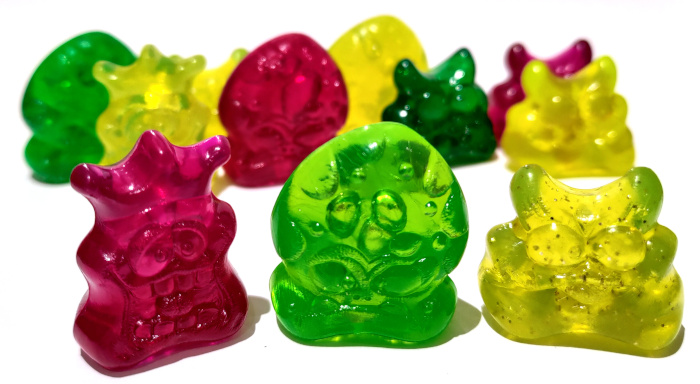Collecting
Collecting Jojo’s is no easy task. Strange colors, rare molds, unique finishes, mixed colors… This guide page will attempt to summarize it all and provide a good overview of what’s really Jojo’s collecting.
Let’s not start chronologically, but with the releases you, English-speaking reader, probably encountered initially.
Imperial Toy’s initial releases
Three years after the launch of the Jojo’s in Israel and two after Europe, LAOR Toys teamed up with Imperial Toy to ensure the production and distribution of Jojo’s in English-speaking countries. Mostly UK, US and Canada.
Basic Colors
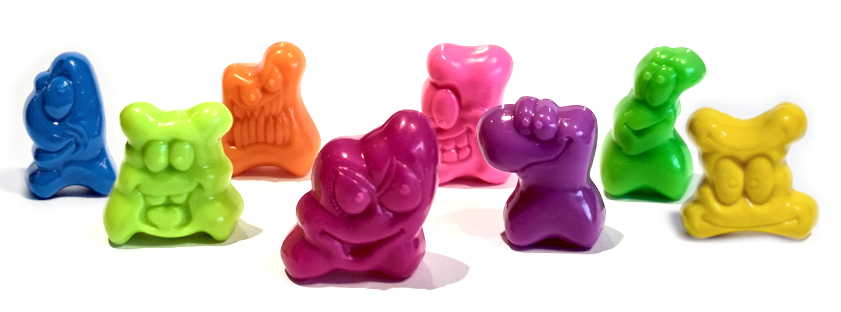
The first color batch was fairly similar to the worldwide one, with seven colors: Blue, Orange, Magenta, Pink, Purple, Green and yellow.
However, the eighth color, Electric yellow is new and (at the time) exclusive to Imperial Toy.
In terms of rarity, certain numbers such as 15 and 21are the least common, but they are still easily obtainable.
Compared to European releases, Imperial Toy isn’t penny-pinching and releases the royal triad in large quantities, mostly in blue, magenta and orange.
Painted special editions
In 1999, Imperial decided to expand the range a little, first by offering 12 of the Jojo’s we know in chrome and painted versions. This resulted in six variations of our eight basic colors, a transparent red variant and a silver one.
Due to the fact that those are solely made by Imperial, slight differences in shade and in shape are observed. The 12 sculpts (being numbers 4 d, 6 f, 10 j, 11 k, 24 x, 26 z, 27 0, 29 2, 31 4, 32 5, 34 7 and 35 8) are updated and Imperial made both painted and unpainted versions.
This means that a completionist collector will require to own a full set of 36 characters in each color plus a full set of 12 characters in the same-ish color, with the updated sculpt and shade.
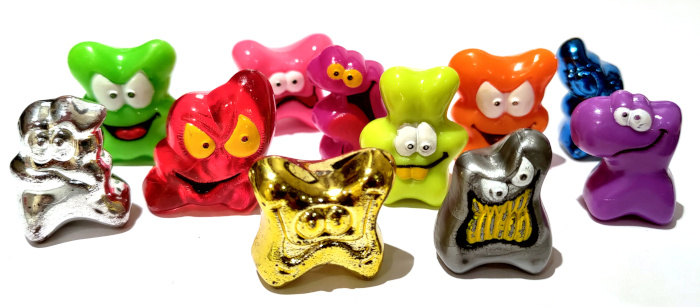
A trained eye will quickly recognize them, otherwise you can look at their backs and see two new mentions: the Imperial Toy logo and a “made in China” label.
The same 12 sculpts were used to make chromed figures in blue, pink, silver and gold.
Series 2
Alongside those new painted and chromed Jojo’s, Imperial Toys released 12 new figures, numbered from 37 to 48. Vastly different in tone and style, these did not encounter the same success and are mostly forgotten today.
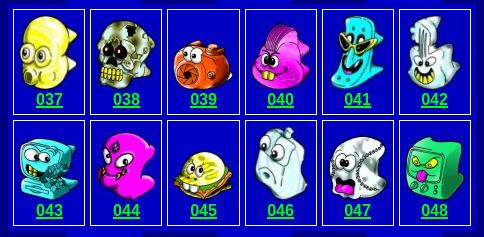
Foreign Jojo’s
Jojo’s released in Western Europe
Due to their history , the very first series of Jojo’s available on the European market back in September 1996 consisted of only 33 numbers, as shown in some
store displays. (34 including 8bis)
Basic colors

This first series, consisting of numbers 2 to 6 and 8 to 36, was released in the seven most common colors: Green, Orange, Blue, Magenta, Pink, Yellow and Purple.
In terms of rarity, it should be noted that certain numbers such as 15, 21, 29 and 8bis are the least common, but they are still easily found.
For colors, purple seems the least present.
Rares Jojo’s
Come on, that’s a title for SEO.
The Royal Triad
Just a few weeks or months after this launch, the series was completed with the introduction of numbers 1, 7 and 8. The 8bis (cap one) is still in the bags, so there are 37 different Jojo’s, including two number eights.

Those last ones, considered “the rare ones,” are! Or at least they were. They were mostly found in blue and magenta, rarely in other colors. As we’ll see later in this guide, these 1/7/8 are almost more common in transparent than in basic opaque colors.
They are believed to have been completely absent from the 2002 EU Jojo’s re-release.
Mega Jojo’s and TF1
If you ever come across a Jojo’s that looks a little bigger than average, it must be a Mega. In the end, very little is known about their distribution. Some rumors say they were in blue bags, but I’ve never found any in them. They are occasionally found on resale sites, but they quickly sold. They don’t come in all shapes, but in a wide variety of colors.
Megas also released in South Africa.
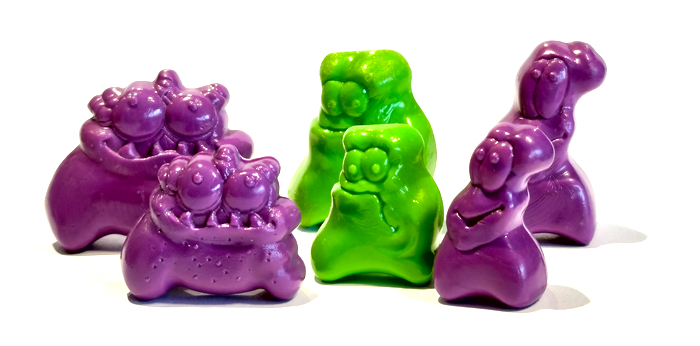
Note the presence of 8bis in Mega version. A curious choice given that its normal/small version was removed from the boxes early.
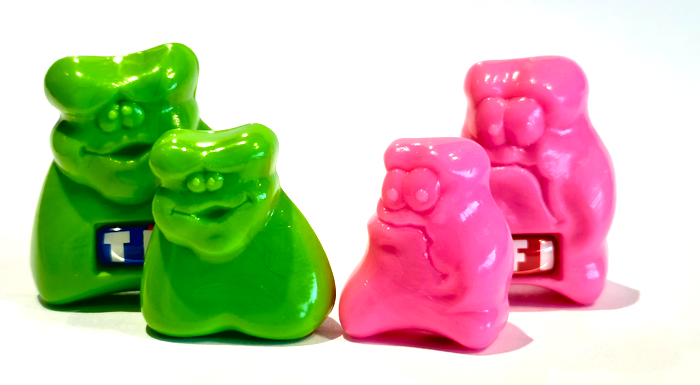
Finally, there is a cousin version of the Megas: the TF1 Megas. These are the same designs, but with an embedded TF1 logo. Here too, the ways to acquire them back in the days remains unknown, although it is believed that they could have been prizes in Minitel competitions.
They are not common, and unfortunately some have since lost their TF1 badge. Just like the Megas, they came in many different colors , which makes a complete collection very complicated.
Promotional Jojo’s
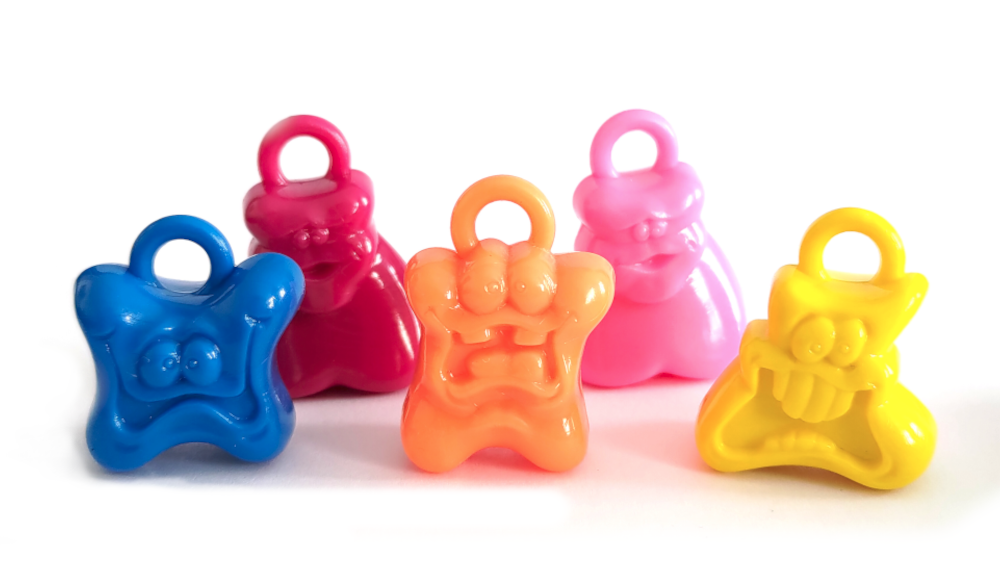
Halfway between the promo and the normal series we find the Necklaces Jojo’s . These do not exist in all shapes or colors and were distributed in red packages, in addition to certain derivative products or promos. Unfortunately they do not stand the test of time well and we often find them with broken ring in lots at garage sales or online.
Read more about the Necklaces Jojo’s >>

In 1996, France had a promotion with Kréma candies, offering an exclusive Jojo’s with the brand’s image: King Kréma. Available in five colors (Blue, Green, Pink, Orange and Silver), they are very rare today and are envied by foreign collectors.
Blues and greens are the most common.
Special colors
Released a little later, the special colors make their appearance. They are distributed in red bags , but also in windowed packs .
We then see the arrival of new colors: White, Gold, Silver, Pearl and Black.
Gold and silver are the most common.
Unfortunately it is not possible to make a complete collection of these colors except for black, there will always be missing numbers.
- White : numbers 21, 22, 23 et 32
- u, v, w, 6
- Gold : numbers 1, 7 et 8
- a, g, h
- Silver : numbers 1, 7, 8 et 15
- a, g, h, o
- Pearl : numbers 1, 6, 7, 8, 21, 22, 23, 32 et 33
- a, f, g, h, u, v, w, 5, 6
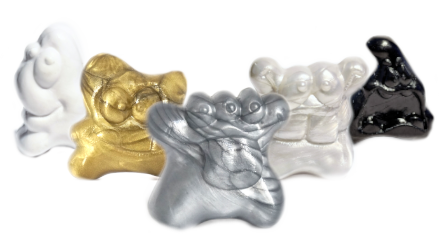
Transparent colors
Still in red bags, many transparent colors have been released. A guide is in preparation to list everything!
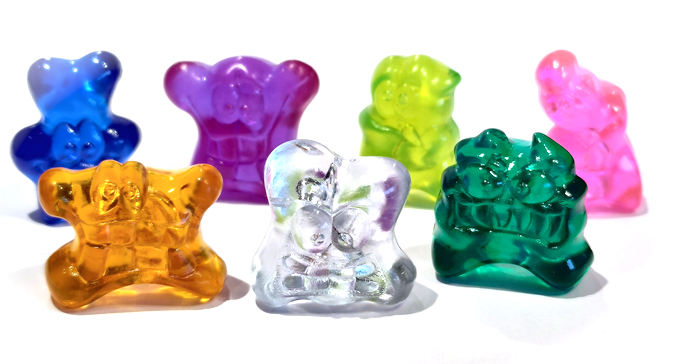
Are they rare? Yes and no. There are so many different colors that completing a set is quite a difficult task, but with a few exceptions, they can’t really be called rare.
Israeli Jojo’s
As explained several times on this site, the very first series of Jojo’s in Israel contained two exclusive Jojo’s that never arrived in Europe, and one that never arrived elsewhere.
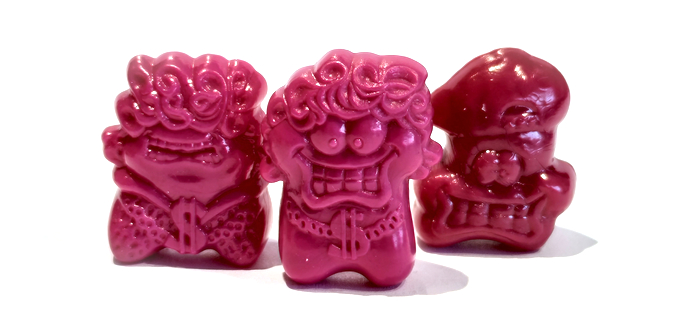
· The first of the three is “Jojo Khalastra” (or 1bis). It is inspired by the Israeli comic character of the same name, the face of the brand.
· The second, 7bis (his name is still unknown to this day) vaguely resembles number 9, Junkyard, dressed as Khalastra. He is sometimes found in keychain format, in metal or plastic.
· Finally, the last one is the famous 8bis (its name is also unknown), or “The Jojo’s with a cap”. Few of these were circulating in early European releases. Of the three, this is therefore the most common.
There is an alternative version of this Jojo’s distributed during a promotion with the Sonol fuel chains .
Bamba Jojo’s
These four Jojo’s were offered in Bambas potato chip bags in 1995, also in Israel. Released only in transparent colors (purple, yellow, and pink), they are now very rare, even in their country of origin.
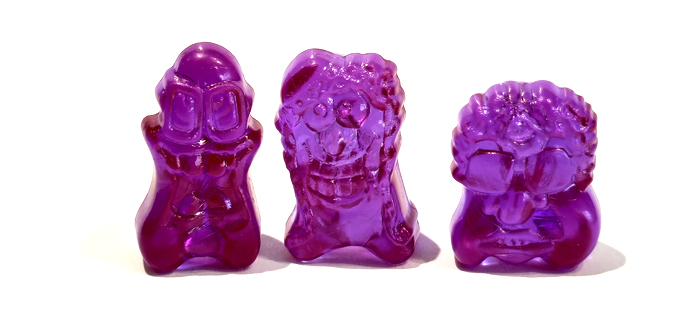
Colors
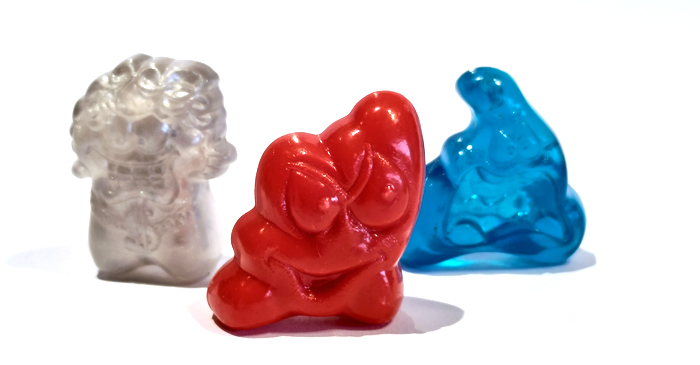
Israeli releases featured some rather unusual colors that we’ve rarely seen outside of the country. These include red, some transparent varieties, and a slightly transparent silver unique to the country. The most impressive finish is the extremely rare glow-in-the-dark finish.
Whether it’s for the figures or their colors, you will absolutely have to rely on fairly expensive imports to obtain them… If you can find any.
This is also where you will find necklaces of 7bis in unusual colors.
In Russia
The Russian children were lucky enough to have two colors that we didn’t have at home: “Russian Red” (the same as in Israel) and a pastel light blue. Only some Jojo’s come in these colors, and their plastic seems much more fragile than usual. Aside from these two, we have our seven European basic colors, but no special or transparent ones.
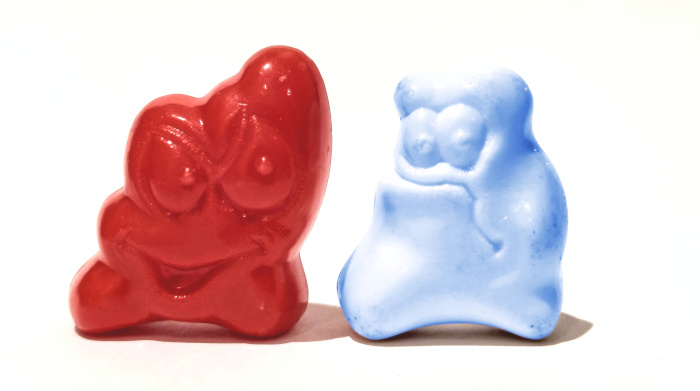
There is rare evidence of issues 1/7/8 being released in Russia, so we can imagine that they were as uncommon as they were in Europe.
In South Africa
Jojos were exported as far away as South Africa, where many seem to say they were very popular. Rumors say the 8bis originated there, but I’ve never been able to confirm or deny these claims.
They were released under the name “Pride Jojo’s “.
What is certain, however, is that there are some exclusive colors that we do not find elsewhere: a set of marbled colors (khaki green marbled white, a marbled black, a variant of turquoise…) and a transparent blue-violet. It is very difficult to establish a scale of rarity as the context of release and the quantity sold are unknown. There are few announcements on second-hand markets and it is generally quite complicated to import them.
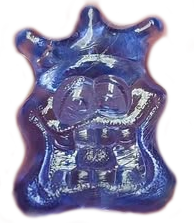
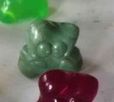
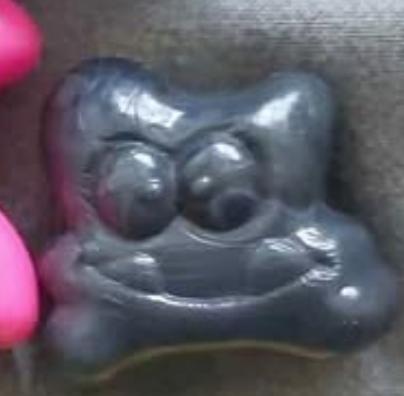
The re-release in Northern Europe
In the late 1990s, Jojo’s arrived in Northern Europe, primarily in Denmark and Sweden. This is probably one of the most interesting releases, as it features a large number of new colors alongside the old ones.
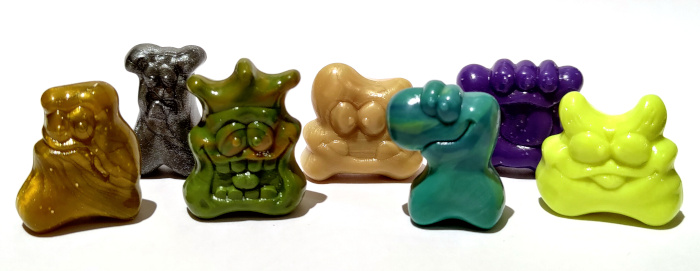
We’re discovering Jojo’s in turquoise, military green, beige and many more. Imperial’s Electric yellow is also there. Strangely, many of these new colors are limited editions, with only about fifteen of the 36 Jojo’s available.
The Danish release also comes with a range of numbers 1, 7, and 8 in transparent colors, and to say the least, they are much less rare than plain ones. This explains why it is much easier to find the royal trio in transparent neon green or transparent red than in opaque yellow or even pink.
